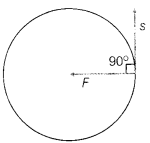What is the amount of work done in the following cases? Justify your answer by giving the appropriate reason.
- By an electron revolving in a circular orbit of radius V around a nucleus.
- By the force of gravity, when a stone of mass ‘m is dropped from the top of a multistoreyed building of height ‘h’.

